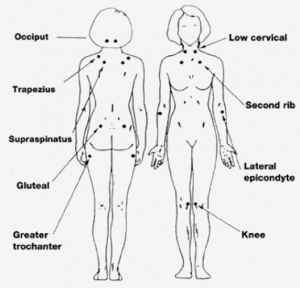Diagnostic Criteria For Fibromyalgia
 Fibromyalgia syndrome has had a long, rather obscure, history as an illness. Concealed behind numerous medical aliases, FMS has existed throughout history and throughout the world. It was only in 1990, however, that official diagnostic criteria for FMS were established by the American College of Rheumatology (ACR). They include the following:
Fibromyalgia syndrome has had a long, rather obscure, history as an illness. Concealed behind numerous medical aliases, FMS has existed throughout history and throughout the world. It was only in 1990, however, that official diagnostic criteria for FMS were established by the American College of Rheumatology (ACR). They include the following:
Bilateral FMS Tender Points As Defined by the ACR
Occiput: at the sub-occipital muscle insertions.
Low Cervical: at the anterior aspects of the inter-transverse spaces at C5-C7.
Trapezius: at the midpoint of the upper border.
Supraspinatus: at origins, above the scapula spine near the medial border.
Second Rib: at the second costochondral junctions, just lateral to the junctions on upper surfaces.
Lateral Epicondyle: 2 cm. distal to the epicondyles.
Gluteal: in upper outer quadrants of buttocks in anterior fold of muscle. Greater Trochanter: posterior to the trochanteric prominence. Knee: at the medial fat pad proximal to the joint line.
Diagnostic Criteria
(1) History of Widespread Pain: Chronic, widespread, musculoskeletal pain for longer than three months in all four quadrants of the body. (Pain above and below the waist and on both sides of the body). In addition, axial skeletal pain (in the cervical spine, anterior chest, thoracic spine, or low back) must be present.
(2) Pain in 11 of 18 Tender Point Sites on Digital Palpation: There are 18 tender points that doctors look for in making a fibromyalgia diagnosis (see Figure). According to the ACR requirements, a patient must have 11 of the 18 to be considered as having fibromyalgia. Approximately four kilograms of pressure (or about 9 lbs.) must be applied to a tender point, and the patient must indicate that the tender point locations are painful.
As the ACR criteria suggest, a fibromyalgia diagnosis requires the “hands-on” evaluation of a patient by a medical professional skilled in fibromyalgia diagnosis. Since patients are not always aware of the specific anatomical origins of pain in their bodies, self- diagnosis is not advised.
Because routine laboratory and x-ray testing is usually normal in fibromyalgia patients, a complete medical history and physical exam by a physician are also crucial for a correct diagnosis. Since the symptoms of fibromyalgia mimic several other diseases (for example, myositis/polymyositis, the nerve damage of diabetes, thyroid disease, rheumatoid arthritis, and others), it is necessary to rule out those conditions before a FMS diagnosis is made.
While a FMS diagnosis does not preclude the co-existence of another condition, one needs to make sure that no other condition is mistaken for fibromyalgia syndrome so that a proper treatment can be initiated
Water aerobics is a very simple exercise that often works quite well for people suffering from fibromyalgia and which is something that you may be interested in trying as well if you are a sufferer yourself.
Especially if you are older in age this is going to be something that you should try, because it is gentle on the body and there is going to be a significantly lower risk of you getting injured in any way.
Diagnostic Criteria For Fibromyalgia



